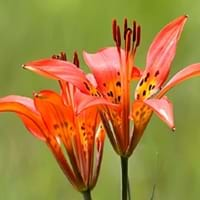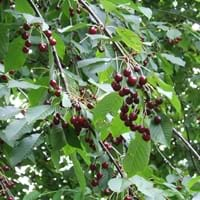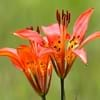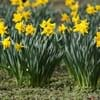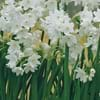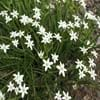Life Span
Perennial
Perennial
Type
Bulb or Corm or Tuber
Fruit
Origin
Northeastern United States, Mid-Atlantic United States, Southeastern United States, North-Central United States, Central United States, South-Central United States, Western United States, Southwestern United States, Texas, Canada
Hybrid origin, Europe, Asia
Types
western red lily
Fruit
Number of Varieties
Not Available
Habitat
High elevation, Hill prairies, Open grasslands
Temperate Regions
USDA Hardiness Zone
3-8
4-8
Sunset Zone
21,22
A2, A3, 1a, 1b, 2a, 2b, 3a, 3b, 4, 5, 6, 7, 8, 9, 14, 15, 16, 17
Habit
Upright/Erect
Upright/Erect
Flower Color
Dark Red, Orange Red
White
Flower Color Modifier
Bicolor
Bicolor
Fruit Color
Yellow green, Sandy Brown
Red, Dark Red
Leaf Color in Spring
Light Green
Dark Green
Leaf Color in Summer
Light Green
Dark Green
Leaf Color in Fall
Several shades of Green
Dark Green
Leaf Color in Winter
Light Green
Light Green
Leaf Shape
Long linear and narrow
Simple lobed or unlobed
Plant Season
Summer
Spring, Summer, Fall
Sunlight
Full Sun, Partial Sun, Partial shade
Full Sun, Partial Sun
Growth Rate
Medium
Medium
Type of Soil
Clay, Loam, Sand
Clay, Loam, Sand
The pH of Soil
Neutral
Acidic, Neutral, Alkaline
Soil Drainage
Well drained
Well drained
Bloom Time
Summer, Late Summer
Spring
Tolerances
Drought
Drought
Where to Plant?
Ground, Pot
Ground
How to Plant?
Bulbs
Semi-hardwood and hardwood cuttings
Plant Maintenance
Medium
Medium
Watering Requirements
Keep the Soil well drained
Keep ground moist, Use Mulches to help prevent water loss during hot and windy weather
In Summer
Lots of watering
Lots of watering
In Spring
Moderate
Moderate
In Winter
Average Water
Average Water
Soil pH
Neutral
Acidic, Neutral, Alkaline
Soil Type
Clay, Loam, Sand
Clay, Loam, Sand
Soil Drainage Capacity
Well drained
Well drained
Sun Exposure
Full Sun, Partial Sun, Partial shade
Full Sun, Partial Sun
Pruning
Remove damaged leaves, Remove dead branches, Remove dead leaves
Remove damaged leaves, Remove dead branches, Remove dead leaves
Fertilizers
Acidic Fertilizer, All-Purpose Liquid Fertilizer
All-Purpose Liquid Fertilizer
Pests and Diseases
Gray mold, Lily Beetle
Birds
Plant Tolerance
Drought
Drought
Flower Petal Number
Single
Single, Double
Foliage Texture
Medium
Medium
Foliage Sheen
Matte
Glossy
Attracts
Birds, Hummingbirds
Birds
Allergy
poisonous to cats
Anaphylaxis, gastro-intestinal problems, Itchiness, Skin irritation
Aesthetic Uses
Borders, Cottage Garden, Ornamental use, Wild gardens
Beautification, Bouquets, Informal Hedge, Landscape Designing, Showy Purposes, Wild gardens
Beauty Benefits
Not Available
Not Available
Edible Uses
Sometimes
Yes
Environmental Uses
Air purification
Air purification
Medicinal Uses
Not Available
anti-inflammatory, Anti-oxidant, Gout, Insomnia, Soothing and relieving pain
Part of Plant Used
Not Available
Flowers, Fruits
Other Uses
bulb used as starch, Unknown
Air freshner, Beneficial species for attracting pollinators, Cake, Edible syrup, Oil is used in perfume, soaps, creams, etc., Used to make juice
Used As Indoor Plant
Yes
No
Used As Outdoor Plant
Yes
Yes
Garden Design
Feature Plant, Mixed Border, Wildflower
Edible, Feature Plant, Fruit / Fruit Tree
Botanical Name
LILIUM philadelphicum
PRUNUS cerasus 'Northstar'
Common Name
Philadelphia Lily, Wood Lily
Northstar Tart Cherry, Pie Cherry 'Northstar'
In Hindi
wood lily
आलूबालू
In German
Lilium philadelphicum
Northstar Tart Cherry
In French
Lilium philadelphicum
Northstar Tart Cherry
In Spanish
lirio de madera
Cereza
In Greek
ξύλο κρίνος
Northstar Tart Cherry
In Portuguese
wood lily
Northstar Tart Cherry
In Polish
lilia drewna
Northstar Tart Cherry
In Latin
wood lily
Northstar Tart Cherry
Phylum
Magnoliophyta
Magnoliophyta
Class
Liliopsida
Magnoliopsida
Family
Liliaceae
Rosaceae
Clade
Angiosperms, Monocots
Angiosperms, Eudicots, Rosids
Tribe
Not Available
Not Available
Subfamily
Lilioideae
Not Available
Number of Species
Not Available
Not Available
Season and Care of Wood Lily and Northstar Tart Cherry
Season and care of Wood Lily and Northstar Tart Cherry is important to know. While considering everything about Wood Lily and Northstar Tart Cherry Care, growing season is an essential factor. Wood Lily season is Summer and Northstar Tart Cherry season is Summer. The type of soil for Wood Lily is Clay, Loam, Sand and for Northstar Tart Cherry is Clay, Loam, Sand while the PH of soil for Wood Lily is Neutral and for Northstar Tart Cherry is Acidic, Neutral, Alkaline.
Wood Lily and Northstar Tart Cherry Physical Information
Wood Lily and Northstar Tart Cherry physical information is very important for comparison. Wood Lily height is 30.00 cm and width 30.50 cm whereas Northstar Tart Cherry height is 180.00 cm and width 240.00 cm. The color specification of Wood Lily and Northstar Tart Cherry are as follows:
Wood Lily flower color: Dark Red and Orange Red
Wood Lily leaf color: Light Green
Northstar Tart Cherry flower color: White
- Northstar Tart Cherry leaf color: Dark Green
Care of Wood Lily and Northstar Tart Cherry
Care of Wood Lily and Northstar Tart Cherry include pruning, fertilizers, watering etc. Wood Lily pruning is done Remove damaged leaves, Remove dead branches and Remove dead leaves and Northstar Tart Cherry pruning is done Remove damaged leaves, Remove dead branches and Remove dead leaves. In summer Wood Lily needs Lots of watering and in winter, it needs Average Water. Whereas, in summer Northstar Tart Cherry needs Lots of watering and in winter, it needs Average Water.
